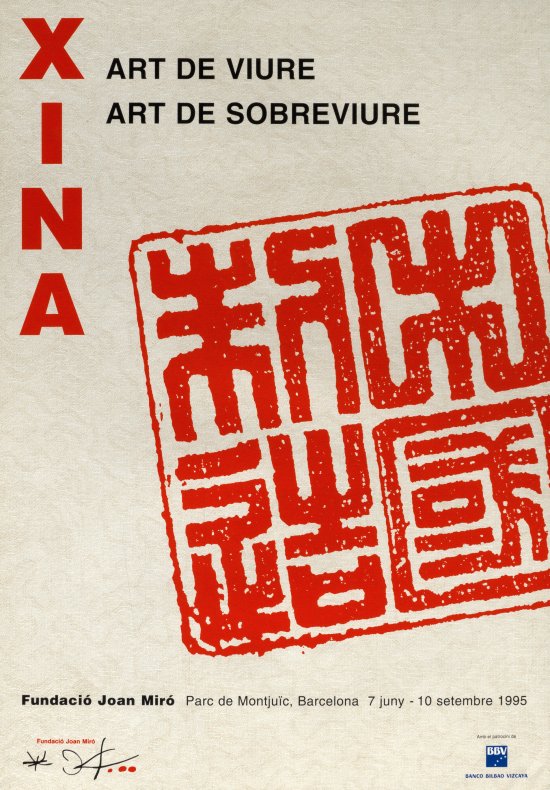- Dates
- —
- Curated by
- Francesc Vicens
China: Art of Living, Art of Surviving
The exhibition China: Art of Living, Art of Surviving, presented by the Fundació, is not structured according to Western rationalist criteria, but according to the poetic concepts that define Chinese creation. It is therefore divided into the following sections:
Being Chinese and Mandarin
Mandarin is hard work. You have to learn philosophy, literature, history, science, and so on. You also have to know the Book of a Thousand Characters and the Book of Five Rules. Along with a series of duties, however, Mandarins enjoyed the privilege of owning objects of extreme beauty, exquisitely embroidered silks, and the right to have concubines from the great families. The Mandarins were the protectors and supporters of the craftsmen of the Great Knowledge. But what is left of the Mandarins today? Old abandoned dwellings, ceilings that evoke a vanished way of life, clothes embroidered with symbolic animals, old books, spectacles made of amethysts.
Materials
The scarcity of certain materials, such as wood or glass, the abundant presence of materials such as bamboo, and the ability to make others from existing raw materials, such as silk, paper or ceramics, have determined the production of all manner of tools and objects in China.
The tradition of paper in China dates back to time immemorial, which explains why typography appeared there much earlier than in Europe. For thousands of years, paper was used to replace glass in windows, to make screens and grids, to separate rooms, and so on.
Ceramics, on the other hand, had characteristics that differed from one region to another, depending on the type of clay and glaze used in each place.
Abstract art was not abstract
For Chinese culture, art cannot represent nothing. The Chinese are always looking for an interpretation of any abstract element, be it in nature or in any other medium. They like to discover landscapes, mythological beings or sacred animals in roots, leaves or the veins of a stone.
Salvaging, a great art
Everything is useful in China. Handicrafts are often the result of recycling other materials. Shreds of old clothes can become an abstract collage of rare beauty, ultimately destined to become the soles of slippers. There is a rejection of waste, but at the same time there is a more subtle idea behind this philosophy of recycling, which is the possibility of giving a new form to an object that already had one.
The circle and the square
Two essential forms dominate Chinese aesthetics: the circle and the square. The circle represents the sky and all that relates to the spiritual world, while the square represents the earth and the more earthly world. The Temple of Heaven is round. On the other hand, the Chinese house, the farmer’s field... are squares. Many everyday objects in China reproduce these two shapes as a symbol of the union between the material and spiritual worlds.
Cooking/medicine/nature
It is very difficult to separate these concepts in Chinese culture. Similar to the use of textile materials, it could be said that everything that enters the kitchen is useful, whether it is for nourishment, and therefore for keeping the body healthy, or for restoring health.
Animals and art
The Chinese value animals for their symbolism and use them to illustrate all manner of objects, such as kites with images of dragons, cushions embroidered with mythological animals, children’s clothes printed with animals that symbolise luck and happiness, gargoyles on the roofs of houses as a symbol of good omens, the depiction of the pig as a symbol of abundance, and so on.
The great attention that they pay to birds and all the utensils used for them also shows the importance of animals in China.
The cricket
The cricket is a source of pleasure for the Chinese, both for the ear and the eye. Some of the objects on display in the exhibition illustrate this cult of the cricket: containers for cricket fighting, brushes made from the hairs of rats’ whiskers to encourage them to fight, and several small boxes like the one in the film The Last Emperor.
The Chinese collector’s wardrobe
The Chinese have a taste for anything that can give them aesthetic pleasure. They therefore collect anything that catches their eye because of its significance, the material of which it is made or its rarity: pipes, paintbrushes, curious objects, spectacles made of amethysts, all with great attention to detail in the workmanship and a heightened sense of aesthetics.
Communication: art and necessity
Writing is used not only to convey information, but also to convey wishes and a call for action. But writing is not the only means of communication. Shadow theatre and opera have a long tradition and great popularity.
The Cultural Revolution
Non-verbal communication became the main propaganda tool of the Cultural Revolution. Mao’s image and the civic and humanitarian deeds attributed to him pervaded the imagery of China at the time.
Being Chinese and a peasant
The Western eye of our time, accustomed to appreciating the material quality of artistic creation, the poverty and simplicity of materials, will find in this section a series of unconscious coincidences between the aesthetics of our time and the often millennia-old forms of rural tools, the peculiar way in which objects are wrapped in string, or the various devices for transporting domestic animals.


